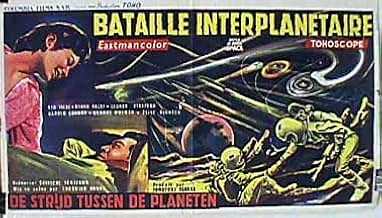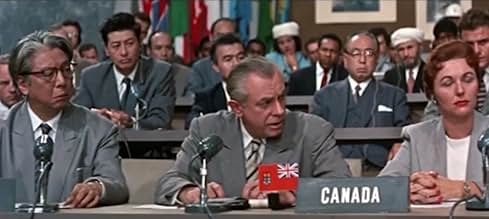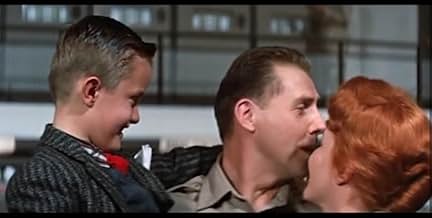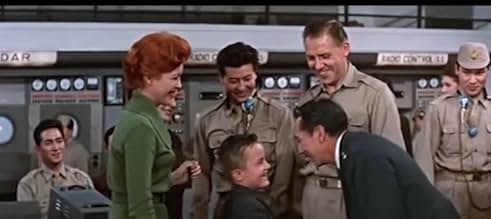VALUTAZIONE IMDb
5,6/10
1725
LA TUA VALUTAZIONE
Aggiungi una trama nella tua linguaThe nations of the Earth unite in a common cause to fight off an invader from outer space.The nations of the Earth unite in a common cause to fight off an invader from outer space.The nations of the Earth unite in a common cause to fight off an invader from outer space.
- Premi
- 1 candidatura in totale
Ryô Ikebe
- Maj. Ichiro Katsumiya
- (as Ryo Ikebe)
Kyôko Anzai
- Etsuko Shiraishi
- (as Kyoko Anzai)
Harold Conway
- Dr. Immerman
- (as Harorudo Konwei)
Elise Richter
- Sylvia
- (as Erisu Rikutâ)
Hisaya Itô
- Kogure
- (as Hisaya Ito)
Nadao Kirino
- Gravity Man
- (as Hiro-o Kirino)
Kôzô Nomura
- Rocket Commander
- (as Kozo Nomura)
Takuzô Kumagai
- Alien
- (as Jirô Kumagai)
Katsumi Tezuka
- Alien
- (as Katsumx Tesuka)
Mitsuo Tsuda
- Air General
- (as Mitsuo Isuda)
- …
Osman Yusuf
- Bystander
- (as Osuman Yusefu)
Recensioni in evidenza
Pint-size aliens from the planet Natal are bent on conquering the Earth in this colorful space opera from the heyday of Toho Studios. Second in a trilogy of space-themed movies directed by the inimitable Ishiro Honda (the other two being "The Mysterians" and "Gorath") this is pure mindless fun.
The special effects may seem dated now, but for the time they were first-rate, much better than your average sci-fi and far superior to any of the monster films Toho cranked out from the mid-60s onward. This was definitely not done on the cheap: The sets are well thought-out, the astronomical backgrounds detailed and quite convincing.
Eiji Tsuburaya's intricate miniature work is amazing as always. The voyage to the Moon, the fight on the lunar surface, and the final showdown (with souped-up X-15s squaring off against alien saucers and a huge mother ship) are elaborately staged and exciting.
Which is why it's easy to forgive the occasional cheesy bits. For instance, when the beautiful SPIP rockets are taking off for the Moon, Honda illustrates the effects of high-G by having one of the crewmen put his hands on either side of his face and *pull* the flesh back. I also suspect they were running out of funds (the film's only 74 minutes long) when it came time to shoot the scene where the alien mother ship tears up downtown Tokyo with a gravity-reversing ray. Although it's a clever effect, apparently achieved by building the models on top of compressed air jets, the sequence feels too short. Plus the miniatures just don't look quite as detailed or realistic, when compared to other Toho films of the era.
My biggest complaint: In the one scene where you actually meet the aliens in the flesh (sort of) they're in spacesuits which make them look like midget Michelin Men and they sound like a bunch of squeaky dog toys. When a crowd of them "menaces" the heroine, there's not a ray gun in the bunch; all they can can do is shuffle, wave their arms and squeak. Not very intimidating, to say the least. (If anything, they're hilariously reminiscent of that roomful of sex-crazed Cub Scouts in Woody Allen's "Everything You Always Wanted To Know About Sex".)
But the good far outweighs the not-so-good in this romp. In a theater, in its original Tohoscope (Toho Studios' equivalent of Cinemascope), it must have been something to see.
(Update: In 2007, an outfit called Monsters in Motion released "Uchu Daisenso" on DVD -- in letterbox, in the original Japanese with English subtitles -- as part of their "Toho Masters" series. With its companion piece "Gorath" available from MiM, and Tokyo Shock's gorgeous edition of "The Mysterians", Honda's entire space trilogy is now obtainable in the original, unedited widescreen versions.)
The special effects may seem dated now, but for the time they were first-rate, much better than your average sci-fi and far superior to any of the monster films Toho cranked out from the mid-60s onward. This was definitely not done on the cheap: The sets are well thought-out, the astronomical backgrounds detailed and quite convincing.
Eiji Tsuburaya's intricate miniature work is amazing as always. The voyage to the Moon, the fight on the lunar surface, and the final showdown (with souped-up X-15s squaring off against alien saucers and a huge mother ship) are elaborately staged and exciting.
Which is why it's easy to forgive the occasional cheesy bits. For instance, when the beautiful SPIP rockets are taking off for the Moon, Honda illustrates the effects of high-G by having one of the crewmen put his hands on either side of his face and *pull* the flesh back. I also suspect they were running out of funds (the film's only 74 minutes long) when it came time to shoot the scene where the alien mother ship tears up downtown Tokyo with a gravity-reversing ray. Although it's a clever effect, apparently achieved by building the models on top of compressed air jets, the sequence feels too short. Plus the miniatures just don't look quite as detailed or realistic, when compared to other Toho films of the era.
My biggest complaint: In the one scene where you actually meet the aliens in the flesh (sort of) they're in spacesuits which make them look like midget Michelin Men and they sound like a bunch of squeaky dog toys. When a crowd of them "menaces" the heroine, there's not a ray gun in the bunch; all they can can do is shuffle, wave their arms and squeak. Not very intimidating, to say the least. (If anything, they're hilariously reminiscent of that roomful of sex-crazed Cub Scouts in Woody Allen's "Everything You Always Wanted To Know About Sex".)
But the good far outweighs the not-so-good in this romp. In a theater, in its original Tohoscope (Toho Studios' equivalent of Cinemascope), it must have been something to see.
(Update: In 2007, an outfit called Monsters in Motion released "Uchu Daisenso" on DVD -- in letterbox, in the original Japanese with English subtitles -- as part of their "Toho Masters" series. With its companion piece "Gorath" available from MiM, and Tokyo Shock's gorgeous edition of "The Mysterians", Honda's entire space trilogy is now obtainable in the original, unedited widescreen versions.)
Aliens are causing havok on Earth. So a bunch of astronauts are sent to the moon to war with these little funny midget aliens. Just a big battle from beginning to end, with the aliens sucking up Tokyo at the end (man is that cool). It is basically like a Japanese Independence Day except not nearly as intense or violent
I saw "Uchu daisenso" or as it was titled when I saw it, Battle in Outer Space" when I was a kid- a long time ago. Now of course the inevitable comparison to modern space operas will reduce the impact of this simple picture, but taken in the context in which I first viewed it, this was a really cool movie. For starters, it was in glorious color, a rarity in sci-fi in the late 50's I can tell you. I saw a lot of horror and sci-fi movies when I was kid and color was rare. And like most Japanese sci-fi imports of the time this was the whole world united against the invading alien hordes. Yeah a little like Independence Day but In "Uchu daisenso" the United Earth already existed. It didn't take an invasion from outer space to unite the planet. Good (relatively speaking!) effects, a noble if simple plot, combined with beautiful Eastmancolor and this was the perfect drive-in movie.
This is Ishiro Hondas take on the classic space opera featuring alien invaders who have designs on Earth and will do anything to enslave mankind. This is a good, but not great, film. The only problem I have with it is that it tends to slow down during the scenes on Earth, especially the conference scenes. However, it picks up during the scenes on the moon and especially during the dogfight scenes featuring the rocket fighters battling the flying saucers. Also, in terms of acting, the best performance in this film definitely belongs to the great Yoshiyo Tsuchiya. Tsuchiya is excellent as the scientist who becomes possessed by the aliens, but becomes a hero who sacrifices himself after he is released from the alien control. He definitely makes this film more watchable.
Usually, one Ishiro Honda's science fiction films use two distinct themes. The first one is using his films as thinly veiled commentaries on socio-political issues (nuclear war, greed or commercialism) and the second is the world getting together for a common purpose. This film definitely follows the latter to a tee. This is definitely one where Honda uses his skill as a director to convey his wish that man would pull together for a common good instead of waiting until a major crisis to come together.
All in all this was a good film, but not a great one, but I still recommend it.
Usually, one Ishiro Honda's science fiction films use two distinct themes. The first one is using his films as thinly veiled commentaries on socio-political issues (nuclear war, greed or commercialism) and the second is the world getting together for a common purpose. This film definitely follows the latter to a tee. This is definitely one where Honda uses his skill as a director to convey his wish that man would pull together for a common good instead of waiting until a major crisis to come together.
All in all this was a good film, but not a great one, but I still recommend it.
I saw this film in 1960 playing with "The Time Machine" as a double feature. Though not as rich in story line as "The Mysterians" this film really takes off when the two Speep earthships go to the moon to battle a base set up by the planet Matal who also fly "Mysterian" style flying saucers. On the moon the action really starts with marvelous raygun battles between the enemy and earth forces. The earth forces possess a marvelous heat ray cannon as well as smaller but potent raygun rifles. Later in the film, the earth forces battle invading flying saucers and a mother ship with X-15 styled fighter craft equipped with heat ray guns. The finale with the mother ship's ray gun destroying Toyko is done quite well.
For the time this film was made, the special effects are quite good. Considering my nickname is ray-gun 3, this is a ten star IMDb vote scale film in that department. I think the best scene in the film is on the moon where one of the crew stays behind with his ray rifle destroying flying saucers so the earth force can get away in their Speep spaceship. This scene is one of the best piece of special effects I have scene in this type of movie. A thought to remember is the film was made 17 to 18 years before "Star Wars". An outstanding accomplishment by Toho studios.
For the time this film was made, the special effects are quite good. Considering my nickname is ray-gun 3, this is a ten star IMDb vote scale film in that department. I think the best scene in the film is on the moon where one of the crew stays behind with his ray rifle destroying flying saucers so the earth force can get away in their Speep spaceship. This scene is one of the best piece of special effects I have scene in this type of movie. A thought to remember is the film was made 17 to 18 years before "Star Wars". An outstanding accomplishment by Toho studios.
Lo sapevi?
- QuizThis film was the first Japanese science fiction film which had the original Japanese cast and crew listed on the posters and other advertising material in the United States.
- BlooperThe funniest bits are the gravity antics. When the first scout ship turns off the thrusters and the crew all unfastens their safety belts, one of them flies up to the ceiling. He is so surprised, clearly no-one told this astronaut that there was no gravity in the spacecraft. They help him down and the chief tells him that there is no gravity in the ship. Then they all begin walking around completely normally.
- Versioni alternativeThe final 16mm prints struck for U.S. television distribution had the final third of the film letterboxed for the widescreen Tohoscope format.
- ConnessioniFeatured in Aweful Movies with Deadly Earnest: Battle in Outer Space (1966)
- Colonne sonoreBurlesque-style Rondo
Composed by Akira Ifukube
I più visti
Accedi per valutare e creare un elenco di titoli salvati per ottenere consigli personalizzati
- How long is Battle in Outer Space?Powered by Alexa
Dettagli
- Data di uscita
- Paese di origine
- Lingue
- Celebre anche come
- Battle in Outer Space
- Azienda produttrice
- Vedi altri crediti dell’azienda su IMDbPro
- Tempo di esecuzione1 ora 30 minuti
- Mix di suoni
- Proporzioni
- 2.35 : 1
Contribuisci a questa pagina
Suggerisci una modifica o aggiungi i contenuti mancanti

Divario superiore
By what name was Inferno nella stratosfera (1959) officially released in India in English?
Rispondi












